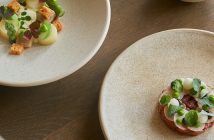Chinese cuisine has a certain preconception in the UK. It is the stuff of tinfoil takeaways and MSG, of gloopy overcooked vegetables and surly service. But at its heart it remains a perennial favourite, indeed the last time it was surveyed, Chinese food came out on top as the nation’s favourite, beating Chicken Tikka Massala and fish and chips, with over a third of the UK’s population favouring it as their go-to takeaway.
Done well, Chinese food can eclipse all others; the flavours, the textures, the inventiveness, with established favourites Hakkasan and Yuatcha leading the pack, newcomers like Hutong in the Shard, and the likes of Duck & Rice tackling the trend setters, not to mention the proliferation of dim sum joints generating queues of hungry diners after a quick bite and a jasmine flower tea.
But where these have brought it into the 21st century with innovation on the menu and a fashion-conscious aesthetic, to get really good ‘old school’ Chinese cuisine, where the duck is ‘Peking’ and the tablecloths are starched, one need only venture to one place – China Tang at The Dorchester.

Located within the hotel, it’s a natural fit with The Dorchester’s glamour, bearing the unmistakable fingerprint of its flamboyant creator, the Hong Kong businessman and socialite Sir David Tang.
Arriving through the gilt-and-marble pomp of the hotel’s tea room, we descend into something evoking the romance of pre-war Shanghai. On one side is The Bar, a 1930s-styled enclave that feels like a minor discovery; carrying an air of elegance and ambassadorial discretion, it’s more akin to a Mayfair private members club than a London watering hole. We select cocktails from a fan – of the paper hand-waving variety – that carry the subtle influence of the East with jasmine and lemongrass, and compare notes with the bartender on their spins on Prohibition-era classics; the Golden Age Martinez, for one, features Baijiu and Szechuan bitters.
En route to the restaurant, we pass lacquered latticework screens and walls adorned with Chinoiserie object d’arts; a visual history lesson and more than a nod to Tang’s sense of humour as Communist era propaganda sit alongside Mandarin movie posters, silk screens and delicate watercolours. The setting is more than sophisticated; here the tablecloths are embroidered, the glasses etched with intricate detailing and, more importantly, the chopsticks are weighted to precision.

As spicy cucumber pieces are offered as a palette cleanser, we put ourselves at Chef Fong’s mercy, taking suggestions from our waiter to select from the myriad of options on the menu. Their signature Peking duck is a given, but we opt to open with a range of dim sum prior, and then move into mains.
We needn’t have worried about over-ordering. Bao like balsawood and dumplings with the density of cannonballs these most certainly are not. The buns were light and airy, bursting with flavour (quite literally in the case of the Siu Long Bao, with soup erupting as you bite into it), and among the classics you’d find in many dim sum diners there are some lovely additions like the beef meatball with tangerine peel and coriander, and the Chiu Chow with scallops and peanuts. Accompanied with a crisp, floral Wachau Gruner Veltleiner, we could happily have made our way through the dim sum all evening.
But there is a real draw here at China Tang, it’s why people come: Peking Duck. Not, simply, by virtue of it as a dish, but how it’s prepared. Waiters practice for over a year to cut it properly and have to pass muster with Fong before they can present it at table. There is, indeed, an art, even theatre, to it as thin sheaves of crispy skin, then meat, are perfectly tapered and presented on the plate. There’s no fork-shredding going on here. It’s designed so that the right amount of fat goes into each slice, to not overfill each pancake and ensure there’s plenty of flavour.

After that, the mains might seem like an afterthought but, remember, everything at China Tang is delicate, time is taken to savour, the meal is a measured experience. When it came to the mains we went old school, with classic Cantonese prawns, stir-fried beef in black pepper, Singapore noodles, and just one departure; lamb with leeks. In keeping with the rest of the meal, we ate from tiny bowls, taking mouthful-sized amounts from each dish and taking our time. It was all strikingly familiar but with one discernible difference; it was unlike any Chinese I’ve had previously. There was not an ounce of stodge, all the flavours were there of their own volition, not burdened by MSG, and cooked to perfection, not overdone and waiting.
Well, perhaps two differences. To accompany this renaissance in Cantonese cuisine, we were recommended a red Sancerre. Strange you may think, as did I, not even being aware there was such a thing; but where a shiraz might be too peppery and overpower, and a pinot too light, this rogue red worked a treat.
To conclude, a much-vaunted dessert ‘platter’ offered promise but, alas, fell into pre-produced restaurant staples; the matcha sorbet proved too sweet, the gold leaf jelly seemed unnecessarily indulgent, and glorified churros didn’t reflect the menu. But, on the other hand, desserts ordered individually offer much more, particularly the chocolate dim sum with a ganache centre, going to prove that if you stick with what they can do best, dinner at China Tang will change your perception of Chinese cuisine, and might just make that nation’s favourite a favourite for a long time to come.
China Tang at The Dorchester, 53 Park Lane, Mayfair, London W1K 1QA. For reservations, tel +44 (0)20 7629 9988 or email reservations@chinatanglondon.co.uk. For more information, including menus and their social media feeds, visit www.chinatanglondon.co.uk.




